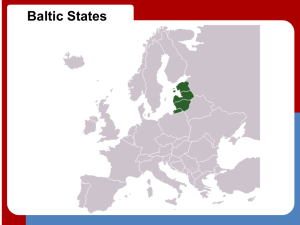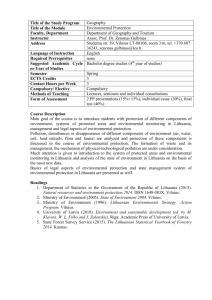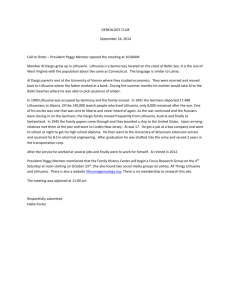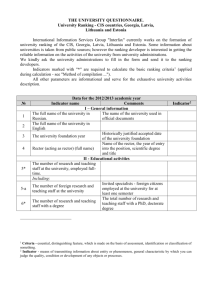Document 10464693
advertisement
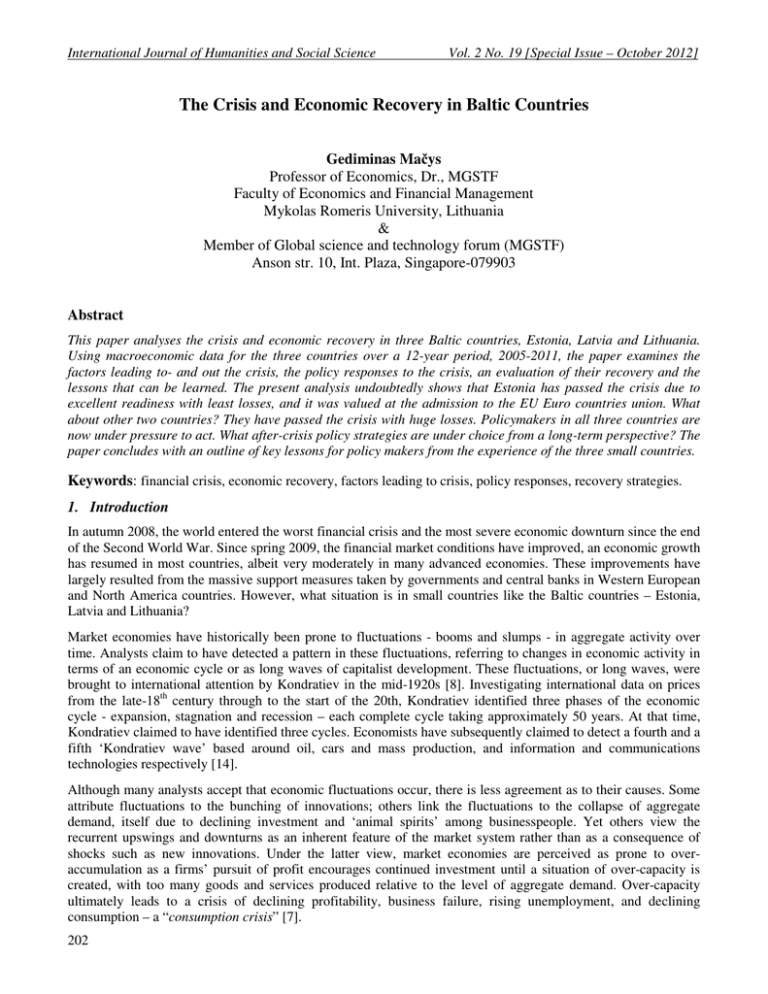
International Journal of Humanities and Social Science Vol. 2 No. 19 [Special Issue – October 2012] The Crisis and Economic Recovery in Baltic Countries Gediminas Mačys Professor of Economics, Dr., MGSTF Faculty of Economics and Financial Management Mykolas Romeris University, Lithuania & Member of Global science and technology forum (MGSTF) Anson str. 10, Int. Plaza, Singapore-079903 Abstract This paper analyses the crisis and economic recovery in three Baltic countries, Estonia, Latvia and Lithuania. Using macroeconomic data for the three countries over a 12-year period, 2005-2011, the paper examines the factors leading to- and out the crisis, the policy responses to the crisis, an evaluation of their recovery and the lessons that can be learned. The present analysis undoubtedly shows that Estonia has passed the crisis due to excellent readiness with least losses, and it was valued at the admission to the EU Euro countries union. What about other two countries? They have passed the crisis with huge losses. Policymakers in all three countries are now under pressure to act. What after-crisis policy strategies are under choice from a long-term perspective? The paper concludes with an outline of key lessons for policy makers from the experience of the three small countries. Keywords: financial crisis, economic recovery, factors leading to crisis, policy responses, recovery strategies. 1. Introduction In autumn 2008, the world entered the worst financial crisis and the most severe economic downturn since the end of the Second World War. Since spring 2009, the financial market conditions have improved, an economic growth has resumed in most countries, albeit very moderately in many advanced economies. These improvements have largely resulted from the massive support measures taken by governments and central banks in Western European and North America countries. However, what situation is in small countries like the Baltic countries – Estonia, Latvia and Lithuania? Market economies have historically been prone to fluctuations - booms and slumps - in aggregate activity over time. Analysts claim to have detected a pattern in these fluctuations, referring to changes in economic activity in terms of an economic cycle or as long waves of capitalist development. These fluctuations, or long waves, were brought to international attention by Kondratiev in the mid-1920s [8]. Investigating international data on prices from the late-18th century through to the start of the 20th, Kondratiev identified three phases of the economic cycle - expansion, stagnation and recession – each complete cycle taking approximately 50 years. At that time, Kondratiev claimed to have identified three cycles. Economists have subsequently claimed to detect a fourth and a fifth ‘Kondratiev wave’ based around oil, cars and mass production, and information and communications technologies respectively [14]. Although many analysts accept that economic fluctuations occur, there is less agreement as to their causes. Some attribute fluctuations to the bunching of innovations; others link the fluctuations to the collapse of aggregate demand, itself due to declining investment and ‘animal spirits’ among businesspeople. Yet others view the recurrent upswings and downturns as an inherent feature of the market system rather than as a consequence of shocks such as new innovations. Under the latter view, market economies are perceived as prone to overaccumulation as a firms’ pursuit of profit encourages continued investment until a situation of over-capacity is created, with too many goods and services produced relative to the level of aggregate demand. Over-capacity ultimately leads to a crisis of declining profitability, business failure, rising unemployment, and declining consumption – a “consumption crisis” [7]. 202 The Special Issue on Business and Social Science © Centre for Promoting Ideas, USA www.ijhssnet.com Access to credit can support consumption for a period of time, but not indefinitely. If credit becomes restricted, or consumers become unable to service their debt, then consumption is likely to decline with consequences for GDP and other macroeconomic indicators. The rational to investigate the economic cycles at different countries is clear and present. When it comes to analyzing the long-term impacts of the crisis on economic development, very simple and highly sophisticated approaches have been presented as well. A simplest hypothesis is based on the expectation that the crisis will only interrupt the development trends, and some years later the trajectories of economic development will bounce back to the old trend lines. The retrenchment scenarios construct a contrasting picture, which assumes a break of trends in the economic development process and a further decline of growth rates compared with the old trends [15]. Putting both impacts together, the breakdown during the crisis and the reduced growth rates later lead to a very pessimistic vision for economic development – while the chances of achieving environmental goals seem to improve. It is obvious that the real development will lie somewhere in between the optimistic and pessimistic scenarios. These remarks unquestionably denote the practical importance of present research, only a detailed discussion on the state and policies during pre-crisis period can give a clear qualification of economic recovery strategies. The innovation of present research effort consists of using macroeconomic data for the three countries over a 12-year period, 2005-2011, and examined from a new perspective, incorporating parallel and rarely interacting strands of literature on global and local crises, political and economic means of recovery. The paper examines also the factors leading to the crisis, the policy responses to the crisis, an evaluation of their recovery and the lessons that can be learned. The objective of present research is to provide the statistical data of pre- and after crisis setting in Baltic countries, and present from the experience of the three small countries the key lessons for policy makers. The paper is structured as follows: the second section provides the crisis in Baltic States. The third section describes the economic recovery in these countries, the fourth section – the lessons learned from the crisis, the fifth section concludes with a discussion and suggestions for further research. 2. Crisis in Baltic countries The three Baltic States are usually presented as one region. The natural, historic, political and socio-economic development of - and business environment in these countries are analogous thereabout. The annual changes of national GDP can provide a rough perception of different paths to - and after the crisis: Fig. 1. The national GDP variations in 2005-2011. 15.00% 10.00 5.00 Lithuania 0.00 -5.00 2005 2006 2007 2008 2009 2010 2011 Latvia Estonia -10.00 -15.00 -20.00 Source: Eurostat data. The economies of three Baltic States have been growing successfully up to 2007, though the different rates of economic growth have also became clear at the early beginning of financial crisis of 2008 (Fig. 1). 203 International Journal of Humanities and Social Science Vol. 2 No. 19 [Special Issue – October 2012] An economy of Lithuania has begun to decay almost one year later but retained, nevertheless, the positive rate of economic growth at the 2.9% level by contraries to the negative rates in Latvia (-3.3%) and Estonia (-3.7%). It means that an economic cycle in Lithuania is running behind in a decade of months as compared with the Latvian and Estonian cycles. The crisis has touched bitterly the Baltic States economies. They have begun to shrink together, and the largest 17.7% decline of economy has been noticed in 2009 in Latvia. The reasons of economic recession were the same in all Baltic countries: the reduced internal consumption due to the reduced incomes of population and fast growing unemployment. The reduced foreign and internal investments, public expenditures and bank credits have become also the important negative factors of economic recessions too (Fig. 2). The deteriorative expectations of consumers have worsened furthermore the internal consumption in Baltic countries. The different scenarios of economic recovery after the crisis have been chosen too [13]. It is interesting to notice that the economies of Lithuania and Estonia have started to unbend earlier than an economy of Latvia. The rates of GDP growth in 2010 were in Lithuania (1.4%), Estonia (2.3%) and conversely in Latvia (-0.3%). On the contrary, the stable means of EU structural support funds were the positive factors in these countries. These means have substituted the substantially vanishing means of direct investments in Latvia and Lithuania (Fig. 2). 25% 20 15 Lithuania Latvia 10 Estonia 5 0 2005 2006 2007 2008 2009 2010 Fig. 2. The foreign direct investments as a share of national GDP in 2005-2010. Source: Eurostat data. According the founder of the economic theory of evolution - J.A. Schumpeter, a crisis fosters structural changes, which are necessary to guide the economy to a new phase of growth, stimulated by new products and new production processes [17]. The state can foster this process by investing in research and development, supporting the implementation of new technology and by public investment in the necessary infrastructure. The structural support means of EU are performing that role in Baltic countries but it is exceptionally essential to complement them by the private investments. It is even more vital for developing countries like the Baltic countries. The foreign direct investments play the important roles in the business development through the new phases of grow [12]. The clear increment of FDI can be noticed after the adhesion into the EU in all three Baltic countries. The FDI flows to Estonia are even large. The FDI in Estonia have even considerably grown to 9.6% level though the crisis nearly interrupted these flows to the level of 0.2% in Lithuania and 0.4% - in Latvia. The FDI flows have grown in 2010 due to the means of EU structural funds and the expanded capitals in the biggest commercial banks of Baltic countries that are the branches of Scandinavian commercial banks. The sale of Eurobonds in Lithuania has given a positive push too. The good business environment, numerous Scandinavian companies and the pending adhesion into the Euro countries club gave a strong push to FDI flow in Estonia. These flows secured and gave a clear support to the fast economic recovery in Estonia. 204 The Special Issue on Business and Social Science © Centre for Promoting Ideas, USA www.ijhssnet.com The strongest process of economic recovery has begun in Estonia due to handling of special fund stores and regaining in short time the past volumes of export, predominantly in the markets in Finland. The growth of Estonian FDUI has reached the 7.6% level in 2011, whereas the annual rates of FDI growth were accordingly less in Lithuania (5.9%) and Latvia (5.5%). These two indexes above clarify the path of economic development. A decline of unemployment rate clarifies the efficiency of economic recovery means. The similar path of unemployment rate can be observed in all three Baltic countries, and a substantial jump of unemployment rate due to turmoil of the crisis can be noticed also in all three countries (Fig. 3). The economic leader is obviously Estonia where an unemployment rate is usually less than in other two countries. 20% 18 16 14 12 10 8 6 4 2 0 Lithuania Latvia Estonia 2005 2006 2007 2008 2009 2010 2011 Fig. 3. An unemployment in 2005-2011. Source: Eurostat data. The unemployment rate in Lithuania has reached the ultimate 17.8% level in 2010 and came to lessen. The more detailed analysis shows that the largest jump of unemployment was observed between young people of 15-25 years old; at that point the unemployment rate of other age groups varies little [11b]. What are the reasons of that unprecedented expansion? Despite of the long-term process of high-education reforms the large part of highschool graduates are still becoming every year the youngest clients of local labour exchange offices due to their clear lack of professional experiences and competences. On other side, the largest part of Lithuanian entrepreneurs and business managers are still under the stress of budget and markets shortages due to the past crisis, and they have no possibilities to undertake the own training courses. As a consequence the rate of unemployment of young Lithuanian people reaches now a high level of 35.1% [9]. The unemployment is close related with the national at-risk-of-poverty-rate (RPR). If some of unemployed people cannot quite a long time to find the workplaces, the own savings can quite fast issue in and the people or families can very fast descend under a poverty level. According our previous research, the RPR varies in Lithuania quite little from 2005 to 2010 [11b]. The highest RPR of two groups - of children and working people of 25-49 years old - is coming to notice, and that high-risk trend continues to grow. The main constraints are familiar in Lithuania and Eastern Europe as well: the shortage of working age people, the lesser wages and lower educational background in the rural areas. The weak social infrastructure does not meet the expectations of young people in rural areas too. The trends of the development of working people market remain the same, tough it has been passed 13 years and the crisis on 2009-2010 [3]. Due to reviving economies the unemployment level has started to lessen in Baltic countries: it reached 15.4% in Lithuania, 15.6% - in Latvia and 12.5% in Estonia (Fig. 3). The dynamics of unemployment rate is quite similar, though it usually was higher in Latvia. The average inflation index is other index of Government policies efficiency. This index has continuously grown excluding the turmoil of incoming crisis of 2009 (Fig. 4). The reasons of inflation slump in all three Baltic countries were the considerable reduction of consumption expenses inside the countries and the depressed world prices for the exporters. 205 International Journal of Humanities and Social Science 18% 16 14 12 10 8 6 4 2 0 -2 -4 Vol. 2 No. 19 [Special Issue – October 2012] Lithuania Latvia Estonia 2005 2006 2007 2008 2009 2010 2011 Fig. 4. An inflation in 2005-2011. Source: Eurostat data. The economic recovery has repaired the downturn of past crisis and has shifted into the conventional level of inflation for Baltic countries, though the Latvia as Lithuania as well show the stern resolution to keep the inflation rate at low level. The question is, how long? The cutting the deficit of the public expenditures of state budget is the next index of successful economic recovery after the crisis in developing countries. The ponderous bureaucratic apparatus was always a painful burden of national budget in Baltic countries except the Estonia. During the period of wholesome economic development the Latvia and Lithuania have shaped the losing budget with a small negative deficit, and at the beginning of crisis their Governments have been not able to retain the constrained low level of budget deficit and started to go down (Fig. 5). 4 % 2 0 -2 2005 2006 2007 2008 2009 2010 Lithuania -4 Latvia -6 Estonia -8 -10 -12 Fig. 5. The national budget deficit as a share of national GDP in 2005-2010. Source: Eurostat data. Estonia has declared the setting-up principle of national budget to keep the surplus national budget, and their efforts were successful except a couple of years during the turmoil of crisis. The European Commission has noticed these efforts and proposed to admit Estonia to the Euro countries union. Estonia has become the 17th member of Euro union on the 1st of Jan. 2011. Despite the fact that Estonia is smallest country as compared with two other Baltic countries, the Estonian financial policy really was most successful. The last statement would be clearer if we could take under analysis the public sector debt of Baltic States. Certainly, the public sector debt was diminishing before the crisis in all Baltic States though Estonia is a clear leader (Fig. 6). 206 The Special Issue on Business and Social Science © Centre for Promoting Ideas, USA www.ijhssnet.com 50 % 45 40 35 30 Lithuania 25 Latvia 20 Estonia 15 10 5 0 2005 2006 2007 2008 2009 2010 Fig. 6. The public sector debt as a share of national GDP in 2005-2010. Source: Eurostat data The situation worsened heavily during the crisis. The largest Latvian debt has reached a level of 44.7% of national GDP due to the nationalisation of local commercial bank “Parex” in 2008. The situation in financial markets has become so tight that the IMF and EU have committed to Latvia the credit of Bill. Euro 7.5 [6]. Latvia has undertaken to reduce the public sector deficit, to pursue the structural reforms and other means. Meanwhile, Estonia has saved up a special fund for crisis long before the crisis and the public sector deficit was 6.7% of national GDP in 2010. It can be noticed that Estonia has passed the crisis without the hard consequences. So, what is a story of economic recovery after crisis? 3. Economic recovery The statistics above and other data decisively show that Estonia has passed the crisis without considerable shock. The consequences of crisis were most complicated in Latvia. The most negative consequence of crisis in Lithuania still is a large national budget deficit. The large Lithuanian commercial banks reside in Scandinavian banks that have clearly conducted the aggressive policies in Lithuania to distribute a lot of real estate credits especially to young working families. These families were mostly the graduates of national and foreign universities and used to serve in large firms or Government institutions. These flows of cheap credits gave a strong boost to building industry at pre-crisis time, i.e. created a real estate bubble like to some extent the analogous bubble in the USA [2]. Unfortunately, the turmoil of crisis has to a large extent destroyed this prosperous situation – the companies have been constrained to cut their expenditures by standing off often a lot of people including these before prosperous families. A lot of poor people especially at working age, a lot of hardly acting companies and diminishable wages, the huge hopeless credit portfolios and diminishable crediting capacities of banks were the main reasons of drastic decline in internal consumer market in Lithuania. It caused a GDP downturn of 14.8% in 2009 and a marginal increase of 1.4% in next year. A missing crisis fund caused unprecedented public debt too. These factors caused a mentioned before GDP downturn. Certainly, the Lithuanian business has also been confronted with diminishing export markets due the crisis in the rest of world. However, the export flows in Lithuania have been reduced at Bill. Euro 4.3 in 2009 comparing with 2008. It would cause only 2-3% of economic shrinkage. The largest part of economic decline is caused by the incompetent policies of the Government and Central Bank of Lithuania up to 2008. The means of economic recovery were similar in all three Baltic countries. The taxes as VAT, excise duties and other have been raised; the tax concessions have been defeated in all three countries. However, the results were different – the public incomes as a share of GDP have grown on 6.7% during 2009 in Estonia, only 0.4% - in Lithuania, and they have shrunk on 0.2% in Latvia. The more conscious culture and more flexible system of taxation, the bigger trust of people in Government institutions have caused the higher public incomes in Estonia. As mentioned before, the Government of Estonia has started the counter crisis means at the beginning of 2008, and Lithuania and Latvia – at the end of 2008. 207 International Journal of Humanities and Social Science Vol. 2 No. 19 [Special Issue – October 2012] The opinions of population were rigorous: the 12% of Lithuanian people assessed positively according the EU survey [16] the counter crisis programme of Government, the 11% - in Latvia and 40% - Estonia. Thus the protest demonstrations have entered in Latvia and Lithuania, and no protests in Estonia. What lessons can be taken from the crisis? 4. Lessons from the crisis A pre-crisis economic growth could alleviate fiscal strains to some extent, by reducing the size of existing debt relative to the size of the economy and by improving the annual budgets including the creation of pre-crisis special fund. This underlines the importance of increasing the Baltic economies’ growth potential. It is therefore crucial to accelerate structural reforms that will reinforce sustainable growth and job creation. Policies that enhance competition and innovation are urgently needed to speed up restructuring and investment, and to create new business opportunities. Increased labour market flexibility is required to create employment and restore competitiveness [10a]. Restructuring of the banking sector, aimed at sound balance sheets, better risk management and increased transparency, is also of the essence. The economic recovery and growth beyond the current period of large-scale deficit spending by governments will require an increase in household consumption especially in Lithuania. Sustained recovery and growth require that this be based on rising real earnings, and not on rising debt. In general terms, the literature identifies three broad categories of strategy in recession conditions: retrenchment, investment, and “ambidextrous” strategies [17]. Retrenchment strategies involve cutting operating costs and divestment of non-core assets. These appear to be the most common approaches adopted by businesses to deal with recession conditions, especially in the shortterm. It is clear from the text above that the divestments of businesses, closures of establishments, reductions in employment; expenditure cuts on a wide range of activities including R&D, marketing and employee training have been put into practice in all three Baltic countries. Investment strategies involve expenditure on innovation and market diversification. Recession is regarded as an opportunity to implement strategic change that would otherwise not have occurred. The evidence on businesses adopting investment strategies to manage through recession, however, is patchy in Baltic countries. Such strategies are risky and many firms are likely to be too preoccupied with short-term survival to think about innovation and growth, or lack the resources to implement such strategies effectively. “Ambidextrous” strategies combine retrenchment and investment. It is likely that most firms adapt under recession conditions through judicious cost/asset-cutting behaviour and through investment in product innovation and market development. Choosing the appropriate investments to make and costs to cut takes on additional importance during recession when market selection pressures are at their most severe. It is obvious that an ambidextrous strategy has been adjusted partially in Estonia. The endless and ineffective quarrels of actual Government with business associations continue to run in Lithuania. The efforts to accomplish an ambidextrous strategy can be noticed in Latvia. 5. Conclusions So, what political lessons can be taken from the experience of Baltic countries? A number of useful lessons can be deduced. The first and most obvious lesson is that vulnerability should be avoided. This means that a Government has to be watchful about the build-up of leveraged debt financing. Beyond a low threshold, the financing of such debt with foreign currency exposures must be avoided. Since the need for debt and external financing arises from the need to grow at any cost, Governments must re-orientate growth strategies. A slower but better quality growth strategy makes sense, one that has a better absorption rate of domestic resources and higher added value. For some analysts, recessions are regarded as periods of ‘creative destruction’, during which some businesses and industries decline, often terminally, while new ideas, technologies, products and industries emerge and become the driving forces of subsequent economic activity and growth [1, 14]. Recession conditions contribute to this economic restructuring through stimulating business churn, the entry and exit of firms, and by motivating incumbent firms to adapt products and business processes. The dynamic, innovative new businesses have an important role to play in leading the economy out of recession. 208 The Special Issue on Business and Social Science © Centre for Promoting Ideas, USA www.ijhssnet.com Adapting to environmental shocks, including recession, is a capability of business leaders to develop in order to survive. One view argues that, during recession, incumbent firms tend to suffer from organisational inertia, which prevents them from adapting appropriately to environmental shocks. Conversely, the “pit-stop” theory of business behaviour in recession treats firms as more willing to innovate because the opportunity costs of not undertaking such action are lower than during more buoyant times. The governments have the roles in encouraging innovation and being more flexible in the delivery of support. This might involve promoting cross-sector and cross-specialism linkages and dialogues with organisations in order to spark ideas for innovation. Propping-up outmoded business models or industries in structural decline, a process accentuated by recession, may be less desirable than more experimental forms of intervention [5, 18]. Many studies identify particular adaptations under recession conditions, such as adjustments in marketing, R&D, training, and pricing. They tend not to report, however, whether such changes constitute a fundamental strategic change, for example, as part of a retrenchment or investment strategy, as distinct from an operational change. The further development of the present analysis needs to focus on macro econometric models of economic and financial crisis and suitable economic recovery measures. References Burakovsky, I. et al. (2009). Coping with the Effects of International Financial Crisis. Searching for Proper Policy Response, Problems of Economic Transition, vol. 51, no. 10, p. 78–96. Buzgalin, A., Kolganov, A. (2009). The Global Economic Crisis and Scenarios for Post crisis Development, Problems of Economic Transition, vol. 52, no. 4, p. 25–4. (2010). Cross-country study. Economic policy challenges in the Baltics, European Commission, Economic and Financial Affairs: Occasional Papers, No. 58, p. 106. [Online]. http://ec.europa.eu/economy_finance/publications/occasional_paper/2010/pdf/ocp58_en.pdf Anastasakis, O., Bastian J., Watson M. (eds.), (2011). From crisis to recovery: sustainable growth in South East Europe, ed. by, SEESOX, University of Oxford, p. 109, Jan. 2011. Jackson, J. K. (2009). The Financial Crisis: Impact on and Response by the European Union, Congress. Res. Service, 36 p. [Online]. http://fpc.state.gov/documents/organization/127015.pdf Nanto, D. K. (2009). The Global Financial Crisis: Analysis and Policy Implications, Congress. Res. Service, 155 p. [Online]. http://fpc.state.gov/documents/organization/127296.pdf Keeley, B., Love P. (2010). From crisis to recovery: the causes, course and consequences of great recession, OECD insights, OECD, p. 147. Kondratieff, N.D. (1926). Die langen Wellen der Konjunktur. (The long waves of economic dynamics). Archiv für Sozialwissenschaft und Sozialpolitik 56, p. 573–609. Lubinaite, S. (2012). Global Financial Crisis Impact on Lithuanian Economy, Bach. Work, Vilnius: M. Romeris Un., p. 93. Macys, G. (2011a). Do the Networks matter: the dynamic Pattern, Int. Journal on GSTF Business Rev., vol. 1, No.2, Oct. 2011. Macys, G. (2012b). Poverty in Lithuania: State and Modelling Premises, Proc. of Int. Virtual Conf. EIIC, Prague, Czech Rep., p. 211-218. Purfield, C., Rosenberg, Ch. B. (2010). Adjustment under a Currency Peg: Estonia, Latvia and Lithuania during the Global Financial Crisis 2008-09, Int. Monet. Fund: Work. Paper, No. 213, p. 35. [Online] http://www.imf.org/external/pubs/ft/wp/2010/wp10213.pdf Real GDP annual change, Eurostat data, [Online] http://epp.eurostat.ec.europa.eu/tgm/table.do?tab=table&init=1&plugin=1&language=en&pcode=tsieb020 Roubini, N., Alesina, A., Cohen, G. D. (1997). Political cycles and the macro economy. MIT Press, Cambridge. Rothengatter, W. et al. (eds.) (2011). Transport Moving to Climate Intelligence, Transportation, Research, Economics and Policy, DOI 10.1007/978-1-4419-7643-7_2, Springer Scie. and Bus. Media, LLC. Stark, J. (2010). The post-crisis strategy for growth and jobs, and modernisation of the global financial architecture between the Committee on Economic and Monetary Affairs of the European Parliament and national parliaments, Brussels, 16 March 2010. Totir, F., Dragota, I. M. (2011). Current Economic and Financial Crisis – New Issues or Returning to the Old Problems? Paradigms, Causes, Effects and Solutions Adopted, Theor. and Appl. Ec. vol. XVIII, no. 1(554), p. 129-150 [Online]. http://store.ectap.ro/articole/547.pdf Tropeano, D. (2011). Financial regulation after the crisis. Where do we stand? Int. Journ. of Polit. Ec., vol. 40, no. 2, p. 45–60. 209


